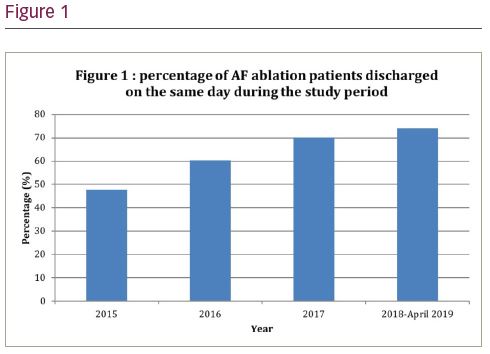Introduction: Atrial fibrillation (AF) ablation is the most common arrhythmia procedure performed worldwide. The number of AF ablation procedures has increased exponentially over the past decade. This has a significant impact on healthcare resources and cost implications. The aim of this study is to evaluate the efficacy and safety of a same-day nurse led discharge protocol in a district general hospital in patients undergoing AF ablation.
Methods: This was a single centre study of all patients undergoing AF ablation from January 2015 to April 2019 at Eastbourne District General Hospital. All patients were admitted as day case procedures with the intention of same day discharge. Nurses discharged patients in the evening of the procedure if there were no procedural complications and if the effects of sedation had subsided. The primary efficacy outcome was the proportion of successful same-day discharges.
Results: A total of 716 patients (mean age 65.9 ± 9.9) underwent AF ablation during the study procedure. The proportion of same day discharges significantly (p<0.001) increased from 47.8% in 2015 to 74% in 2018/19 (Figure 1). The majority of cases (56.4%) were performed using cryoablation. 21.4%, 6.1% and 16% of ablations were performed using PVAC catheter, nMARQ catheter and point by point catheters. The proportion of procedures performed using cryoablation increased year on year from 23% in 2015, 58% in 2016, 52% in 2017 and 72% from 2018 to April 2019. 96.1% of cases were performed using conscious sedation only. In patients who were discharged the same day there were no readmissions 24 hours after the procedure. Patients were who were discharged the same day were more likely to have a shorter procedure time (67.6 ± 26.2 vs 84.0 ± 33.7 minutes, p<0.001) and a lower CHA2DS2-VASc score (2.3 ± 1.5 vs 2.7 ± 1.6, p value <0.001). Cases performed on morning lists were more likely be discharged the same day (74.5% vs 52.6%, p<0.001). Patients who had a procedural complication were also more likely to be admitted for monitoring and an overnight stay (8.8% vs 1.9%, p<0.001).
Conclusion: Same day nurse led AF ablation discharge is feasible and safe in the majority of patients. This helps to reduce costs and increase the number of beds available in the hospital trust. Over the study period the proportion of same day discharges increased which is likely due to increased confidence of the nursing staff to discharge patients on the same day and the increased use of cryoablation technology.








